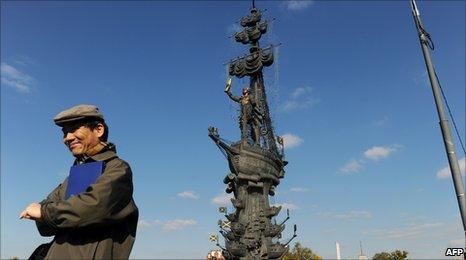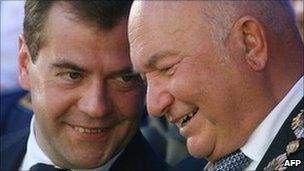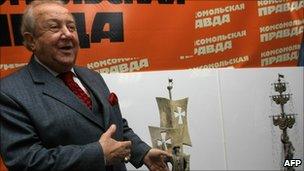Moscow gripped by 'ugly statue' row
- Published

Peter the Great could be knocked off his pedestal - at least in Moscow
He was one of the tallest rulers in Russian history. At more than 2m (6ft 6in), Tsar Peter I towered over his subjects. You can understand why they called him Peter the Great.
But that's nothing compared to the statue of Peter down by the Moscow River.
It's a tad taller than the Statue of Liberty - and heavier, too: 600 tons of stainless steel, bronze and copper.
Tsar Peter is standing behind the wheel of a frigate, clutching a golden scroll.
Rather bizarrely, bits of other ships are sticking out from under his feet. The massive structure rests on an artificial island.
'Disgusting'
Curiously, Peter the Great hated Moscow - and Muscovites seem to feel the same way about this statue.
"That's the ugliest statue of the end of the 20th Century," says Vladimir, who lives in an apartment block opposite the large tsar.
"I see it all the time. All the time! Although I don't notice it as much now: the eye doesn't see what it doesn't like!"
On a bridge opposite the statue, I ask passers-by what they think of the oversized tsar.
"It's disgusting!" one man tells me.
"It's awful," says a woman, "It's just too huge. Big doesn't mean beautiful!"
Moscow rumours
But now, 13 years after he was installed here, Peter is in danger of being knocked off his pedestal. And Russian politics is at play.
It was Yuri Luzhkov who commissioned the statue in the 1990s.

President Medvedev said Mr Luzhkov had lost his "trust"
Mr Luzhkov used to be one of Russia's most powerful politicians. He was Moscow mayor for 18 years until he fell out with the Kremlin.
Last month President Dmitry Medvedev sacked him. And that's when Tsar Peter came under attack.
While he was acting mayor, Vladimir Resin hinted that the infamous statue should be moved.
The speaker of the upper house of the Russian parliament said it should be despatched to St Petersburg.
Moscow has been abuzz with rumours: that the tsar will be chopped up into pieces and sent to the scrap heap; or taken down and banished from the Russian capital.
Even if it costs $10m (£6m) dollars to remove it, Muscovites are unlikely to shed any tears.
"I find it repulsive. It disfigured the historical panorama in this particular section of the Moscow River," believes Moscow journalist Konstantin von Eggert.
"It was also one of the first symbols of the city authority imposing itself on Muscovites, this complete disregard of civic feeling. As such, I want it to be shifted somewhere where it will not be so offensive to born and bred Muscovites like myself."
Tumbling down
It wouldn't be the first statue in Russia to lose its footing. Russian history is littered with fallen idols.
When Soviet leaders denounced Josef Stalin as a despot in the 1950s, most of the Stalin statues in the country disappeared.
And when the Soviet Union itself was falling apart three decades later, other communist statues came tumbling down.
"I remember 1991 when the statue of Comrade Dzerzhinsky, the founder of the KGB, was removed from Lubyanka Square," recalls Pavel Kuznetsov, Deputy Director of the National Museum of Architecture.
"It was like a symbolic act of saying goodbye to the previous epoch. In this sense, I understand the wish of the public and politicians now to say goodbye to the epoch of Mr Luzhkov in Moscow."
'Schizophrenics and madmen'
But not everyone is so understanding.
Sculptor Zurab Tsereteli shows me round his Moscow gallery.
Mr Tsereteli is the man who made the 94m-high (308ft) Peter the Great statue.

Sculptor Zurab Tsereteli says he knows what he is doing and will continue doing it
Among his other works on display in the gallery is a statue of Mayor Luzhkov playing tennis and one of Vladimir Putin in judo costume.
There's also a gigantic apple that you can walk into and which is decorated with naked figures.
Mr Tsereteli is a controversial artist: critics denounce his art as pompous and tasteless.
But Mr Luzhkov clearly liked it. When he was mayor, Mr Tsereteli's statues popped up all over the city.
So is Tsar Peter's creator upset by all the negative comments?
"The trouble is, we've got so many crazy people in Russia today - you can't keep track of them all," Mr Tsereteli says.
"They're all schizophrenics and madmen. They get a bit tired and go bonkers. I try not to take any notice. I'm an artist. I know what I'm doing - and I will continue doing it."
Mr Tsereteli's family shares his anger.
"It's ridiculous!" believes his grandson, Vasili, who runs the Moscow Museum of Modern Art.
"There are so many problems in Moscow, like corruption and traffic jams. And we're talking about burying $10m just to move the Peter statue who knows where!"
The fate of the infamous statue could become clear soon.
This week Moscow has a new mayor - Kremlin-nominated Sergei Sobyanin, a deputy prime minister.
It will be up to him to decide if Peter can stay put - or whether the Tsar and his ship must sail off into history.
- Published15 October 2010
- Published28 September 2010